Financial Strategies & Funding in Travel & Tourism Businesses
VerifiedAdded on 2024/04/26
|38
|5236
|179
Report
AI Summary
This report provides a detailed analysis of finance and funding within the travel and tourism industry. It explores the importance of costs and volume in financial management, using Carnival Corporation & plc as a case study, and analyzes various pricing methods employed in the sector. The study also examines factors influencing profit for travel and tourism businesses, again using Carnival Corporation's cruise brands as an example. Furthermore, it explains different types of management accounting information and assesses their use as decision-making tools. The report includes an interpretation of Dalata Hotel Group plc's financial accounts for 2016, comparing performance against the previous year, and analyzes sources and distribution of funding for capital projects associated with tourism. The study concludes by summarizing key findings and highlighting the role of financial management in the success of travel and tourism businesses.
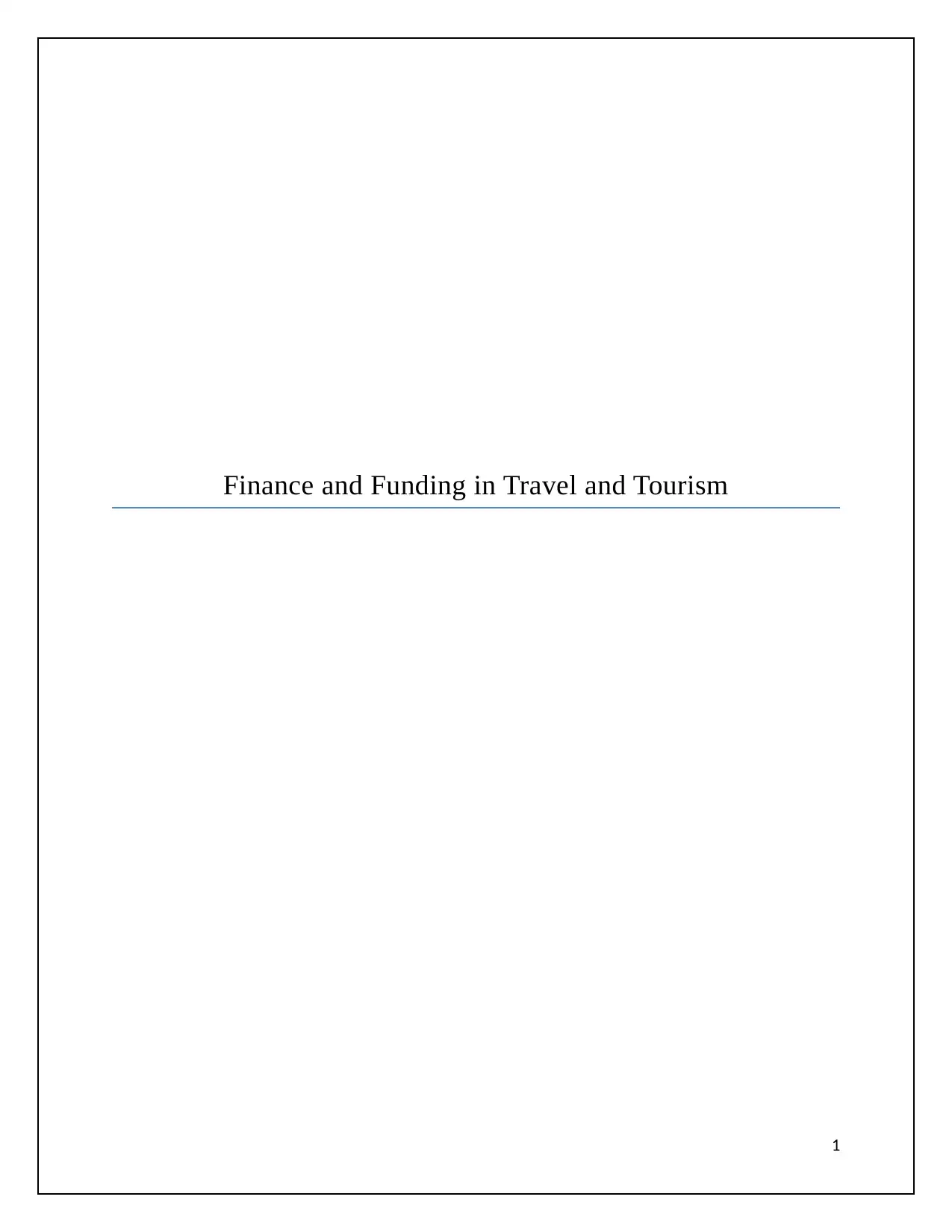
Finance and Funding in Travel and Tourism
1
1
Paraphrase This Document
Need a fresh take? Get an instant paraphrase of this document with our AI Paraphraser
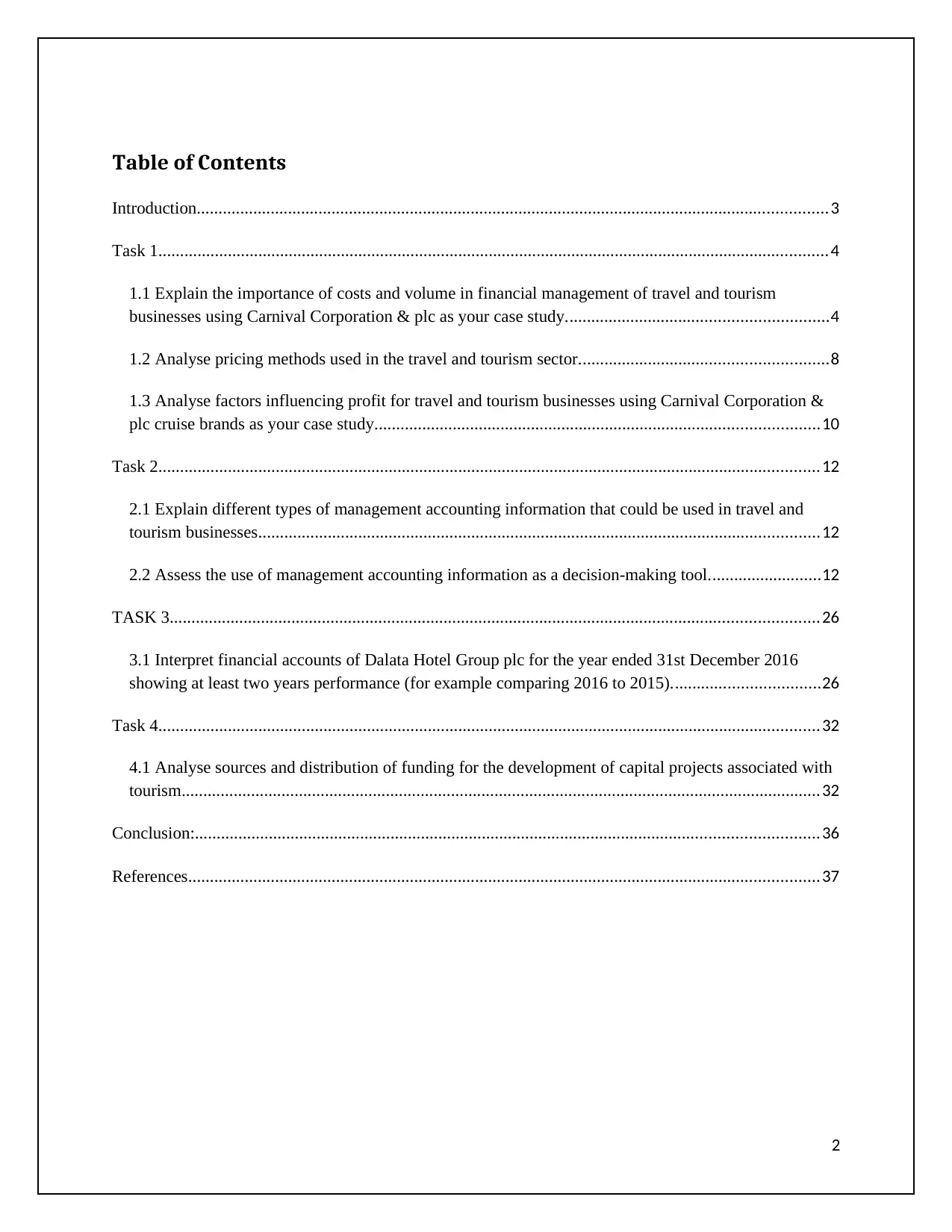
Table of Contents
Introduction.................................................................................................................................................3
Task 1..........................................................................................................................................................4
1.1 Explain the importance of costs and volume in financial management of travel and tourism
businesses using Carnival Corporation & plc as your case study............................................................4
1.2 Analyse pricing methods used in the travel and tourism sector.........................................................8
1.3 Analyse factors influencing profit for travel and tourism businesses using Carnival Corporation &
plc cruise brands as your case study......................................................................................................10
Task 2........................................................................................................................................................12
2.1 Explain different types of management accounting information that could be used in travel and
tourism businesses.................................................................................................................................12
2.2 Assess the use of management accounting information as a decision-making tool..........................12
TASK 3.....................................................................................................................................................26
3.1 Interpret financial accounts of Dalata Hotel Group plc for the year ended 31st December 2016
showing at least two years performance (for example comparing 2016 to 2015)..................................26
Task 4........................................................................................................................................................32
4.1 Analyse sources and distribution of funding for the development of capital projects associated with
tourism...................................................................................................................................................32
Conclusion:...............................................................................................................................................36
References.................................................................................................................................................37
2
Introduction.................................................................................................................................................3
Task 1..........................................................................................................................................................4
1.1 Explain the importance of costs and volume in financial management of travel and tourism
businesses using Carnival Corporation & plc as your case study............................................................4
1.2 Analyse pricing methods used in the travel and tourism sector.........................................................8
1.3 Analyse factors influencing profit for travel and tourism businesses using Carnival Corporation &
plc cruise brands as your case study......................................................................................................10
Task 2........................................................................................................................................................12
2.1 Explain different types of management accounting information that could be used in travel and
tourism businesses.................................................................................................................................12
2.2 Assess the use of management accounting information as a decision-making tool..........................12
TASK 3.....................................................................................................................................................26
3.1 Interpret financial accounts of Dalata Hotel Group plc for the year ended 31st December 2016
showing at least two years performance (for example comparing 2016 to 2015)..................................26
Task 4........................................................................................................................................................32
4.1 Analyse sources and distribution of funding for the development of capital projects associated with
tourism...................................................................................................................................................32
Conclusion:...............................................................................................................................................36
References.................................................................................................................................................37
2
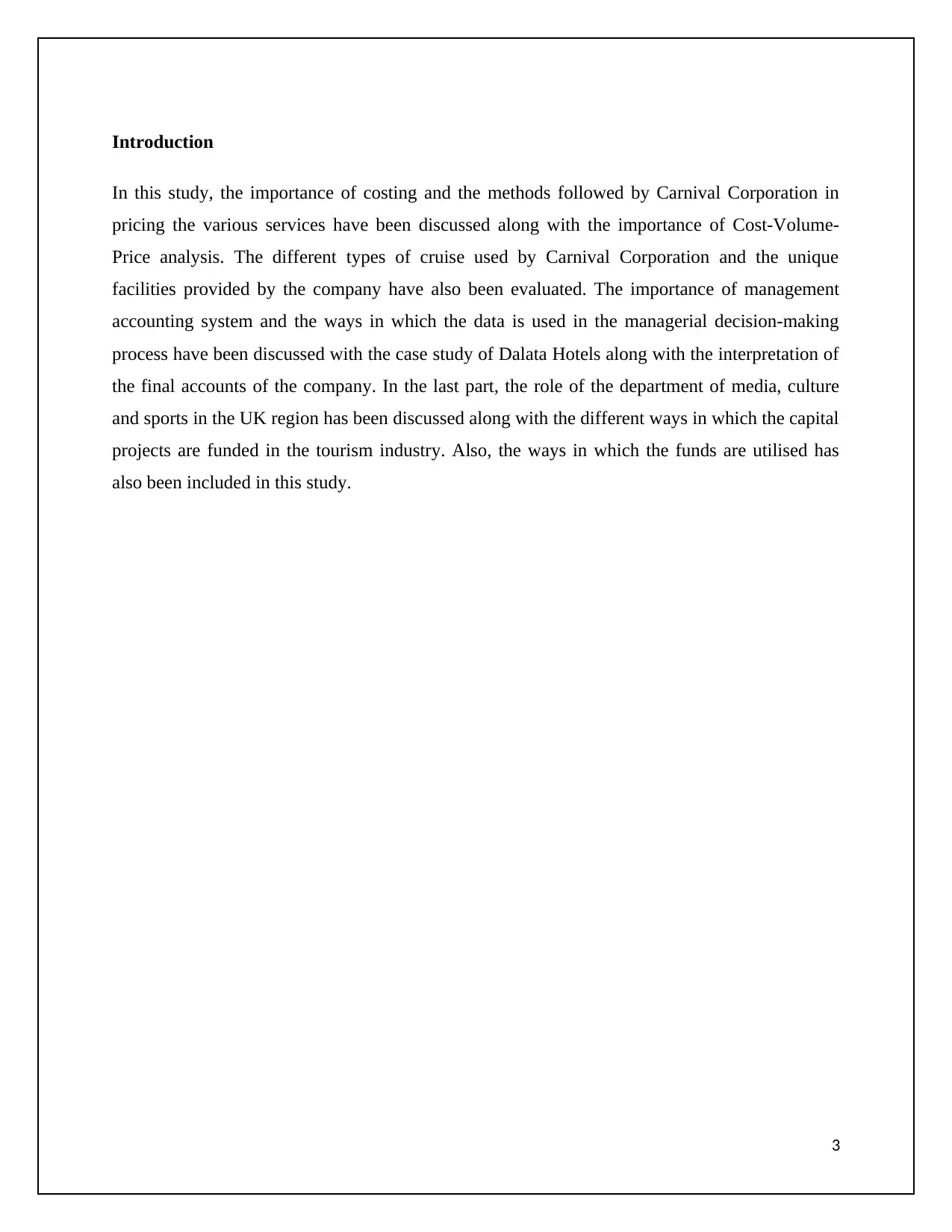
Introduction
In this study, the importance of costing and the methods followed by Carnival Corporation in
pricing the various services have been discussed along with the importance of Cost-Volume-
Price analysis. The different types of cruise used by Carnival Corporation and the unique
facilities provided by the company have also been evaluated. The importance of management
accounting system and the ways in which the data is used in the managerial decision-making
process have been discussed with the case study of Dalata Hotels along with the interpretation of
the final accounts of the company. In the last part, the role of the department of media, culture
and sports in the UK region has been discussed along with the different ways in which the capital
projects are funded in the tourism industry. Also, the ways in which the funds are utilised has
also been included in this study.
3
In this study, the importance of costing and the methods followed by Carnival Corporation in
pricing the various services have been discussed along with the importance of Cost-Volume-
Price analysis. The different types of cruise used by Carnival Corporation and the unique
facilities provided by the company have also been evaluated. The importance of management
accounting system and the ways in which the data is used in the managerial decision-making
process have been discussed with the case study of Dalata Hotels along with the interpretation of
the final accounts of the company. In the last part, the role of the department of media, culture
and sports in the UK region has been discussed along with the different ways in which the capital
projects are funded in the tourism industry. Also, the ways in which the funds are utilised has
also been included in this study.
3
⊘ This is a preview!⊘
Do you want full access?
Subscribe today to unlock all pages.

Trusted by 1+ million students worldwide
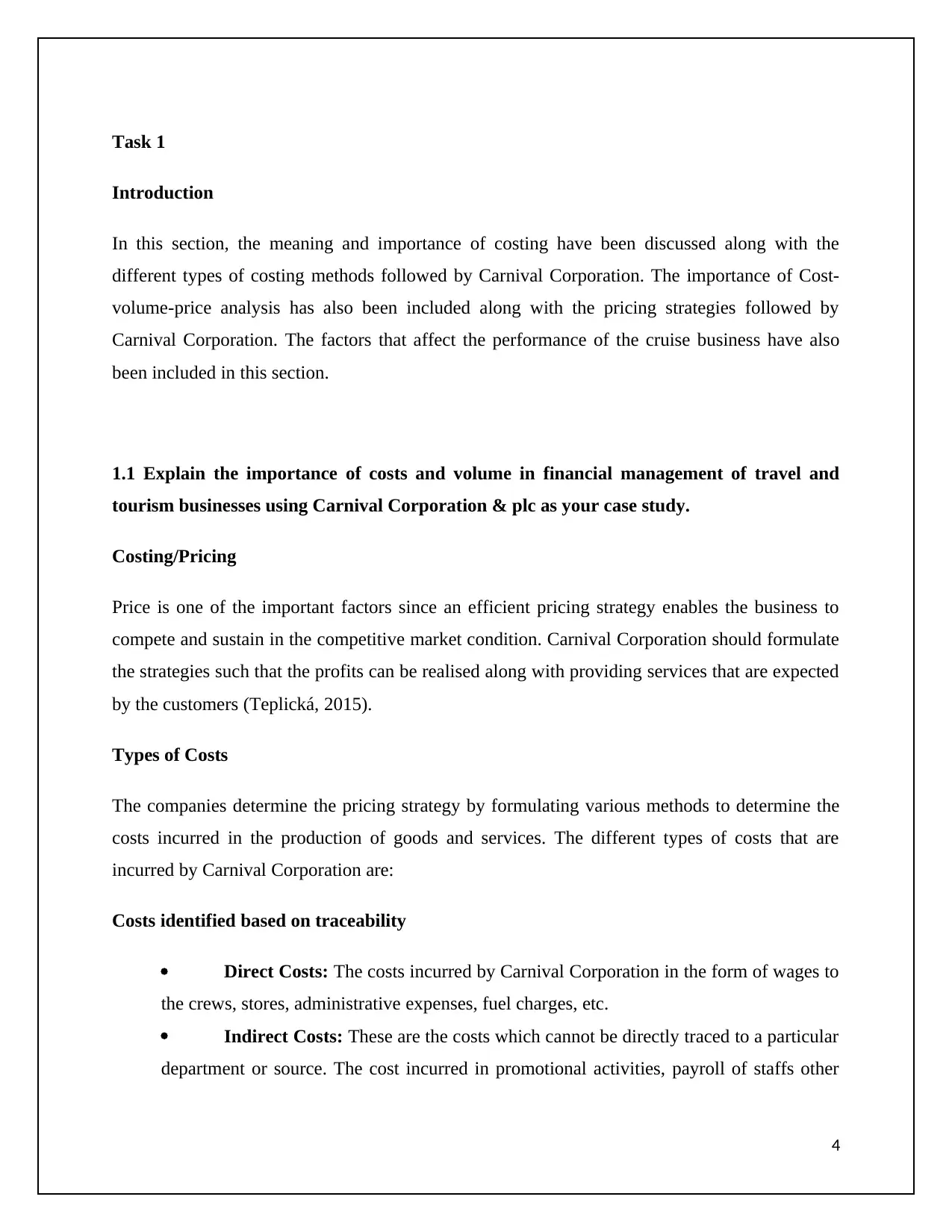
Task 1
Introduction
In this section, the meaning and importance of costing have been discussed along with the
different types of costing methods followed by Carnival Corporation. The importance of Cost-
volume-price analysis has also been included along with the pricing strategies followed by
Carnival Corporation. The factors that affect the performance of the cruise business have also
been included in this section.
1.1 Explain the importance of costs and volume in financial management of travel and
tourism businesses using Carnival Corporation & plc as your case study.
Costing/Pricing
Price is one of the important factors since an efficient pricing strategy enables the business to
compete and sustain in the competitive market condition. Carnival Corporation should formulate
the strategies such that the profits can be realised along with providing services that are expected
by the customers (Teplická, 2015).
Types of Costs
The companies determine the pricing strategy by formulating various methods to determine the
costs incurred in the production of goods and services. The different types of costs that are
incurred by Carnival Corporation are:
Costs identified based on traceability
Direct Costs: The costs incurred by Carnival Corporation in the form of wages to
the crews, stores, administrative expenses, fuel charges, etc.
Indirect Costs: These are the costs which cannot be directly traced to a particular
department or source. The cost incurred in promotional activities, payroll of staffs other
4
Introduction
In this section, the meaning and importance of costing have been discussed along with the
different types of costing methods followed by Carnival Corporation. The importance of Cost-
volume-price analysis has also been included along with the pricing strategies followed by
Carnival Corporation. The factors that affect the performance of the cruise business have also
been included in this section.
1.1 Explain the importance of costs and volume in financial management of travel and
tourism businesses using Carnival Corporation & plc as your case study.
Costing/Pricing
Price is one of the important factors since an efficient pricing strategy enables the business to
compete and sustain in the competitive market condition. Carnival Corporation should formulate
the strategies such that the profits can be realised along with providing services that are expected
by the customers (Teplická, 2015).
Types of Costs
The companies determine the pricing strategy by formulating various methods to determine the
costs incurred in the production of goods and services. The different types of costs that are
incurred by Carnival Corporation are:
Costs identified based on traceability
Direct Costs: The costs incurred by Carnival Corporation in the form of wages to
the crews, stores, administrative expenses, fuel charges, etc.
Indirect Costs: These are the costs which cannot be directly traced to a particular
department or source. The cost incurred in promotional activities, payroll of staffs other
4
Paraphrase This Document
Need a fresh take? Get an instant paraphrase of this document with our AI Paraphraser
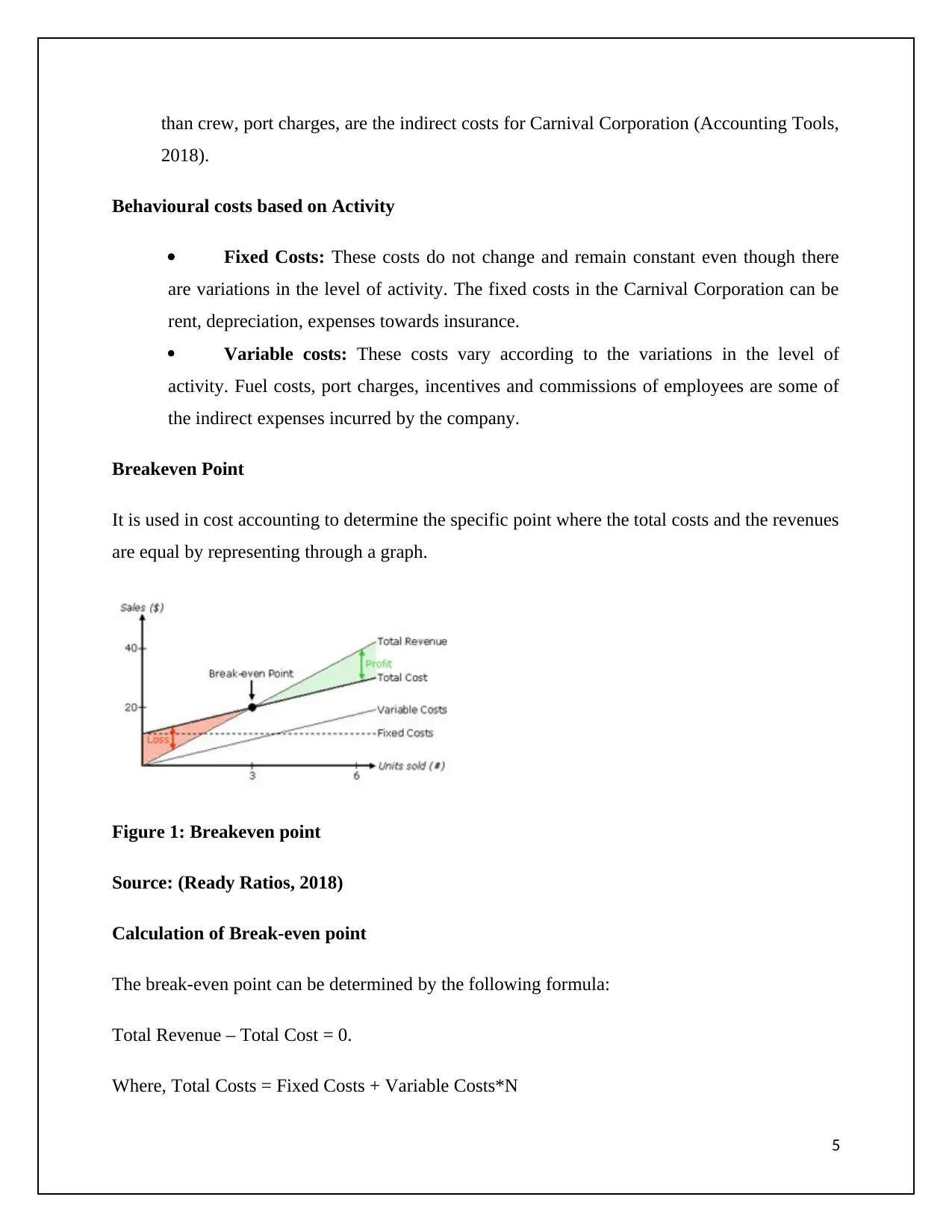
than crew, port charges, are the indirect costs for Carnival Corporation (Accounting Tools,
2018).
Behavioural costs based on Activity
Fixed Costs: These costs do not change and remain constant even though there
are variations in the level of activity. The fixed costs in the Carnival Corporation can be
rent, depreciation, expenses towards insurance.
Variable costs: These costs vary according to the variations in the level of
activity. Fuel costs, port charges, incentives and commissions of employees are some of
the indirect expenses incurred by the company.
Breakeven Point
It is used in cost accounting to determine the specific point where the total costs and the revenues
are equal by representing through a graph.
Figure 1: Breakeven point
Source: (Ready Ratios, 2018)
Calculation of Break-even point
The break-even point can be determined by the following formula:
Total Revenue – Total Cost = 0.
Where, Total Costs = Fixed Costs + Variable Costs*N
5
2018).
Behavioural costs based on Activity
Fixed Costs: These costs do not change and remain constant even though there
are variations in the level of activity. The fixed costs in the Carnival Corporation can be
rent, depreciation, expenses towards insurance.
Variable costs: These costs vary according to the variations in the level of
activity. Fuel costs, port charges, incentives and commissions of employees are some of
the indirect expenses incurred by the company.
Breakeven Point
It is used in cost accounting to determine the specific point where the total costs and the revenues
are equal by representing through a graph.
Figure 1: Breakeven point
Source: (Ready Ratios, 2018)
Calculation of Break-even point
The break-even point can be determined by the following formula:
Total Revenue – Total Cost = 0.
Where, Total Costs = Fixed Costs + Variable Costs*N
5
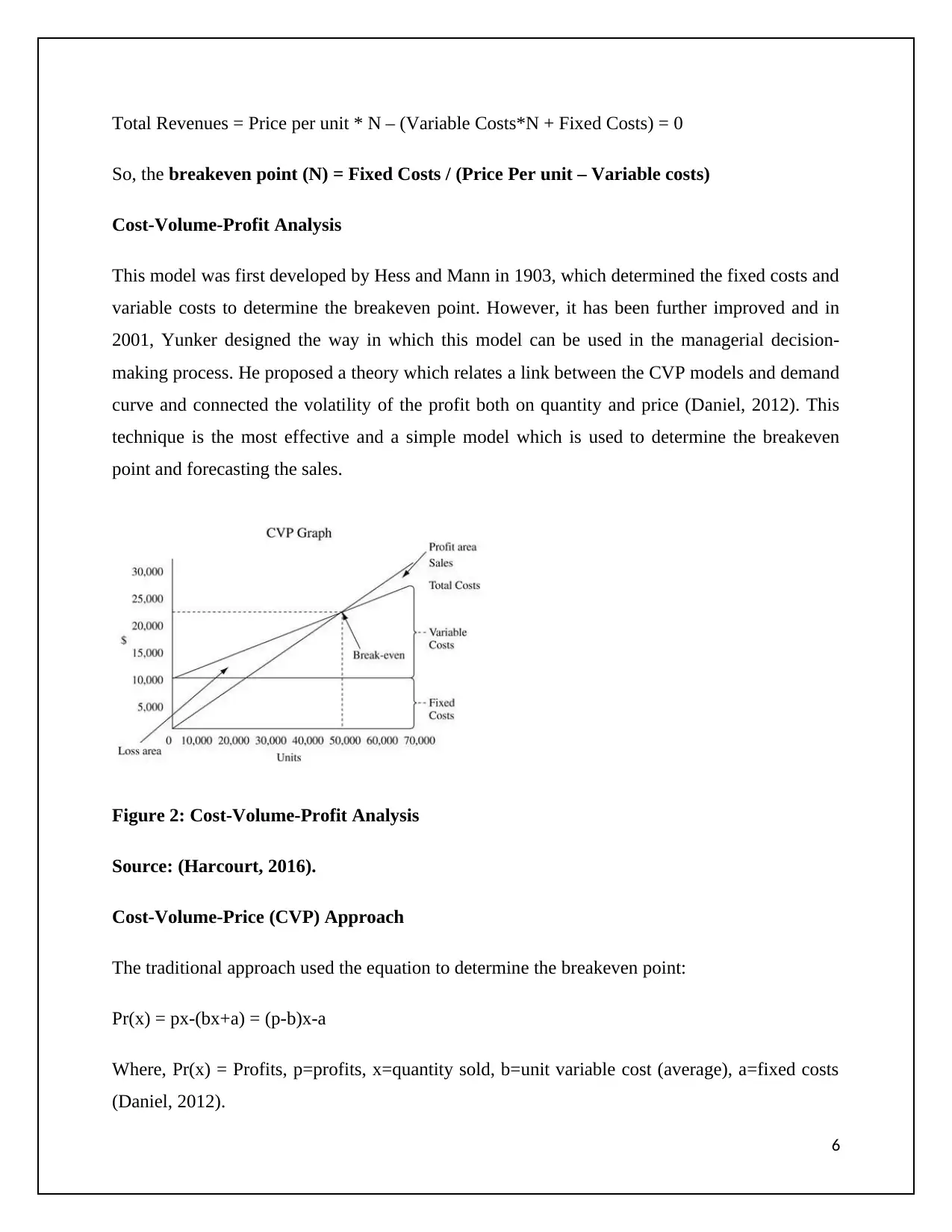
Total Revenues = Price per unit * N – (Variable Costs*N + Fixed Costs) = 0
So, the breakeven point (N) = Fixed Costs / (Price Per unit – Variable costs)
Cost-Volume-Profit Analysis
This model was first developed by Hess and Mann in 1903, which determined the fixed costs and
variable costs to determine the breakeven point. However, it has been further improved and in
2001, Yunker designed the way in which this model can be used in the managerial decision-
making process. He proposed a theory which relates a link between the CVP models and demand
curve and connected the volatility of the profit both on quantity and price (Daniel, 2012). This
technique is the most effective and a simple model which is used to determine the breakeven
point and forecasting the sales.
Figure 2: Cost-Volume-Profit Analysis
Source: (Harcourt, 2016).
Cost-Volume-Price (CVP) Approach
The traditional approach used the equation to determine the breakeven point:
Pr(x) = px-(bx+a) = (p-b)x-a
Where, Pr(x) = Profits, p=profits, x=quantity sold, b=unit variable cost (average), a=fixed costs
(Daniel, 2012).
6
So, the breakeven point (N) = Fixed Costs / (Price Per unit – Variable costs)
Cost-Volume-Profit Analysis
This model was first developed by Hess and Mann in 1903, which determined the fixed costs and
variable costs to determine the breakeven point. However, it has been further improved and in
2001, Yunker designed the way in which this model can be used in the managerial decision-
making process. He proposed a theory which relates a link between the CVP models and demand
curve and connected the volatility of the profit both on quantity and price (Daniel, 2012). This
technique is the most effective and a simple model which is used to determine the breakeven
point and forecasting the sales.
Figure 2: Cost-Volume-Profit Analysis
Source: (Harcourt, 2016).
Cost-Volume-Price (CVP) Approach
The traditional approach used the equation to determine the breakeven point:
Pr(x) = px-(bx+a) = (p-b)x-a
Where, Pr(x) = Profits, p=profits, x=quantity sold, b=unit variable cost (average), a=fixed costs
(Daniel, 2012).
6
⊘ This is a preview!⊘
Do you want full access?
Subscribe today to unlock all pages.

Trusted by 1+ million students worldwide
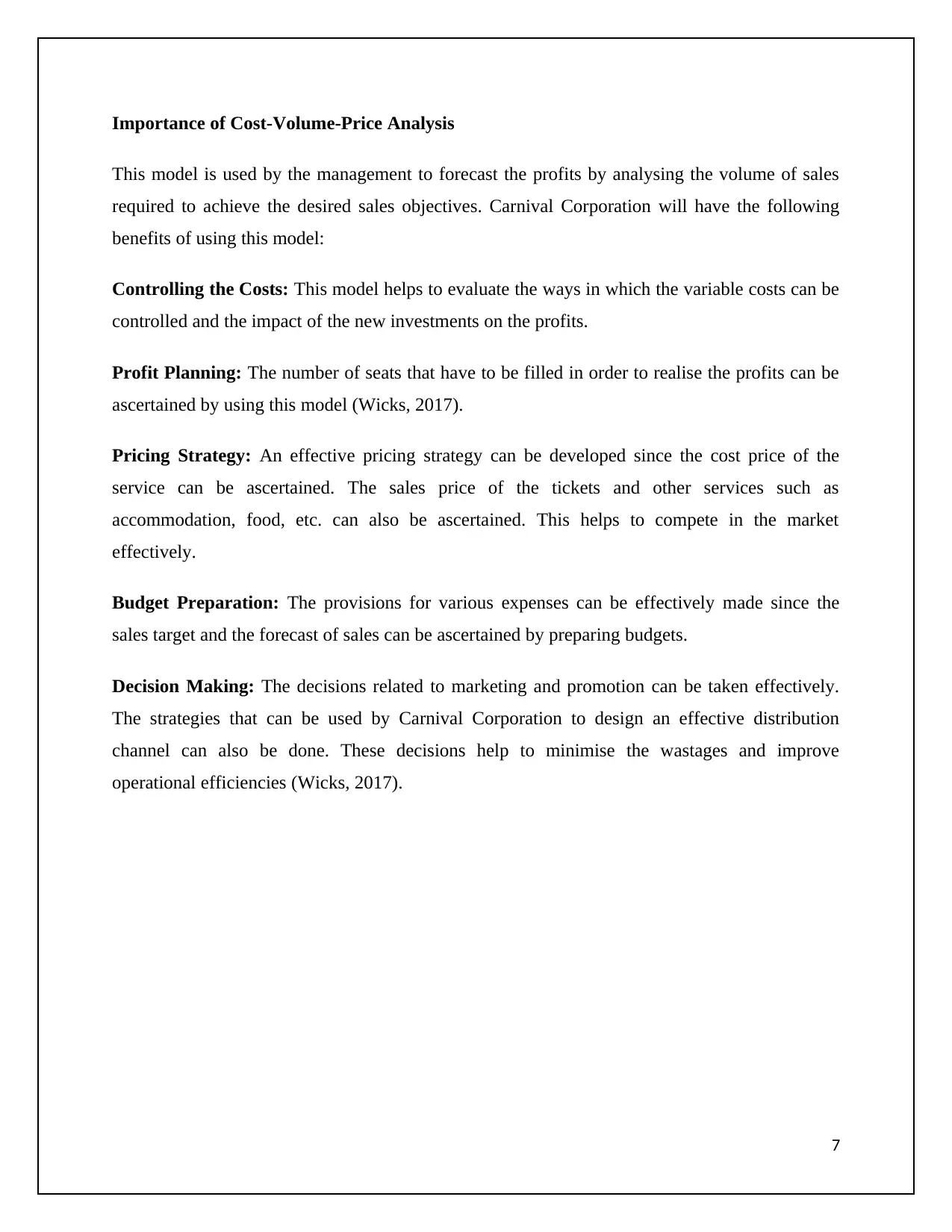
Importance of Cost-Volume-Price Analysis
This model is used by the management to forecast the profits by analysing the volume of sales
required to achieve the desired sales objectives. Carnival Corporation will have the following
benefits of using this model:
Controlling the Costs: This model helps to evaluate the ways in which the variable costs can be
controlled and the impact of the new investments on the profits.
Profit Planning: The number of seats that have to be filled in order to realise the profits can be
ascertained by using this model (Wicks, 2017).
Pricing Strategy: An effective pricing strategy can be developed since the cost price of the
service can be ascertained. The sales price of the tickets and other services such as
accommodation, food, etc. can also be ascertained. This helps to compete in the market
effectively.
Budget Preparation: The provisions for various expenses can be effectively made since the
sales target and the forecast of sales can be ascertained by preparing budgets.
Decision Making: The decisions related to marketing and promotion can be taken effectively.
The strategies that can be used by Carnival Corporation to design an effective distribution
channel can also be done. These decisions help to minimise the wastages and improve
operational efficiencies (Wicks, 2017).
7
This model is used by the management to forecast the profits by analysing the volume of sales
required to achieve the desired sales objectives. Carnival Corporation will have the following
benefits of using this model:
Controlling the Costs: This model helps to evaluate the ways in which the variable costs can be
controlled and the impact of the new investments on the profits.
Profit Planning: The number of seats that have to be filled in order to realise the profits can be
ascertained by using this model (Wicks, 2017).
Pricing Strategy: An effective pricing strategy can be developed since the cost price of the
service can be ascertained. The sales price of the tickets and other services such as
accommodation, food, etc. can also be ascertained. This helps to compete in the market
effectively.
Budget Preparation: The provisions for various expenses can be effectively made since the
sales target and the forecast of sales can be ascertained by preparing budgets.
Decision Making: The decisions related to marketing and promotion can be taken effectively.
The strategies that can be used by Carnival Corporation to design an effective distribution
channel can also be done. These decisions help to minimise the wastages and improve
operational efficiencies (Wicks, 2017).
7
Paraphrase This Document
Need a fresh take? Get an instant paraphrase of this document with our AI Paraphraser
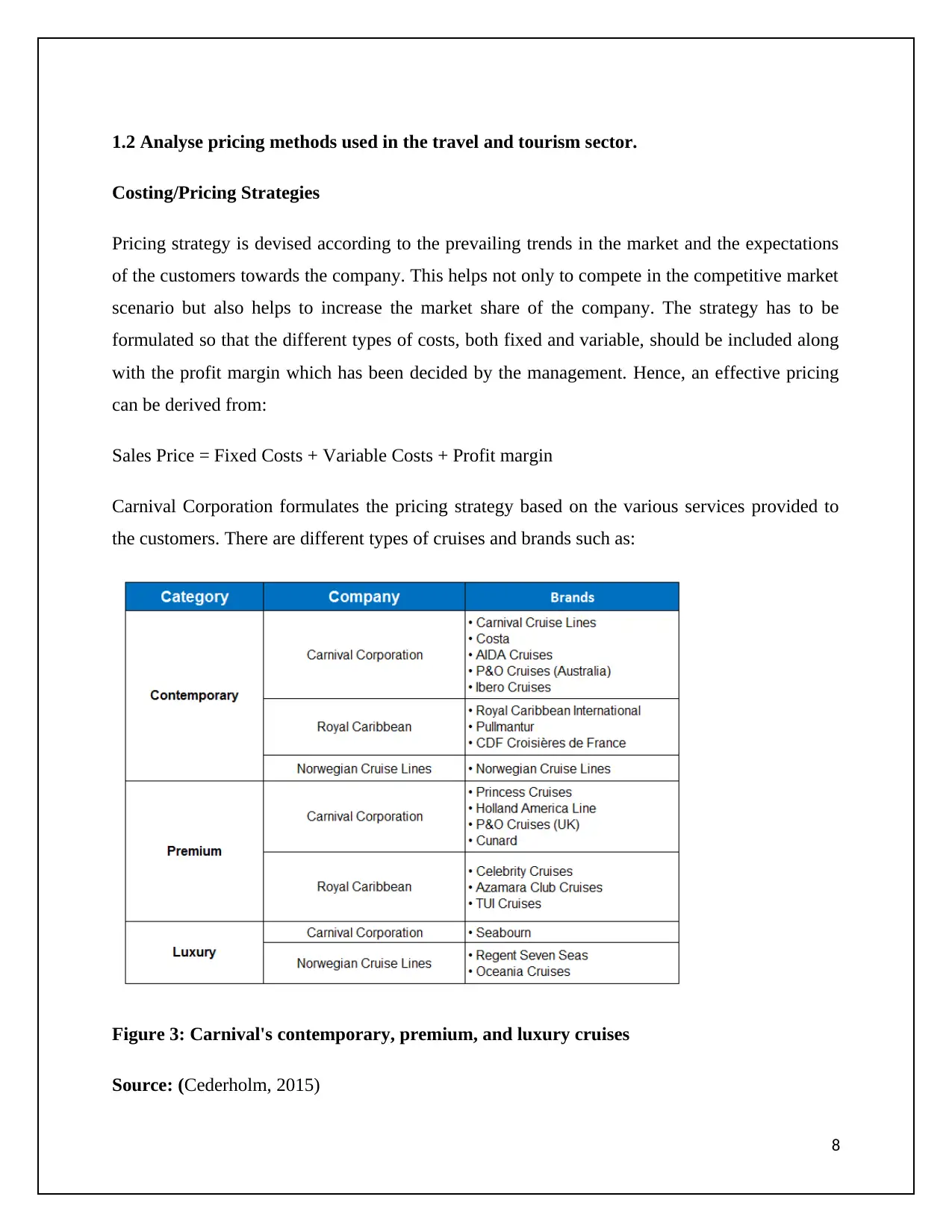
1.2 Analyse pricing methods used in the travel and tourism sector.
Costing/Pricing Strategies
Pricing strategy is devised according to the prevailing trends in the market and the expectations
of the customers towards the company. This helps not only to compete in the competitive market
scenario but also helps to increase the market share of the company. The strategy has to be
formulated so that the different types of costs, both fixed and variable, should be included along
with the profit margin which has been decided by the management. Hence, an effective pricing
can be derived from:
Sales Price = Fixed Costs + Variable Costs + Profit margin
Carnival Corporation formulates the pricing strategy based on the various services provided to
the customers. There are different types of cruises and brands such as:
Figure 3: Carnival's contemporary, premium, and luxury cruises
Source: (Cederholm, 2015)
8
Costing/Pricing Strategies
Pricing strategy is devised according to the prevailing trends in the market and the expectations
of the customers towards the company. This helps not only to compete in the competitive market
scenario but also helps to increase the market share of the company. The strategy has to be
formulated so that the different types of costs, both fixed and variable, should be included along
with the profit margin which has been decided by the management. Hence, an effective pricing
can be derived from:
Sales Price = Fixed Costs + Variable Costs + Profit margin
Carnival Corporation formulates the pricing strategy based on the various services provided to
the customers. There are different types of cruises and brands such as:
Figure 3: Carnival's contemporary, premium, and luxury cruises
Source: (Cederholm, 2015)
8
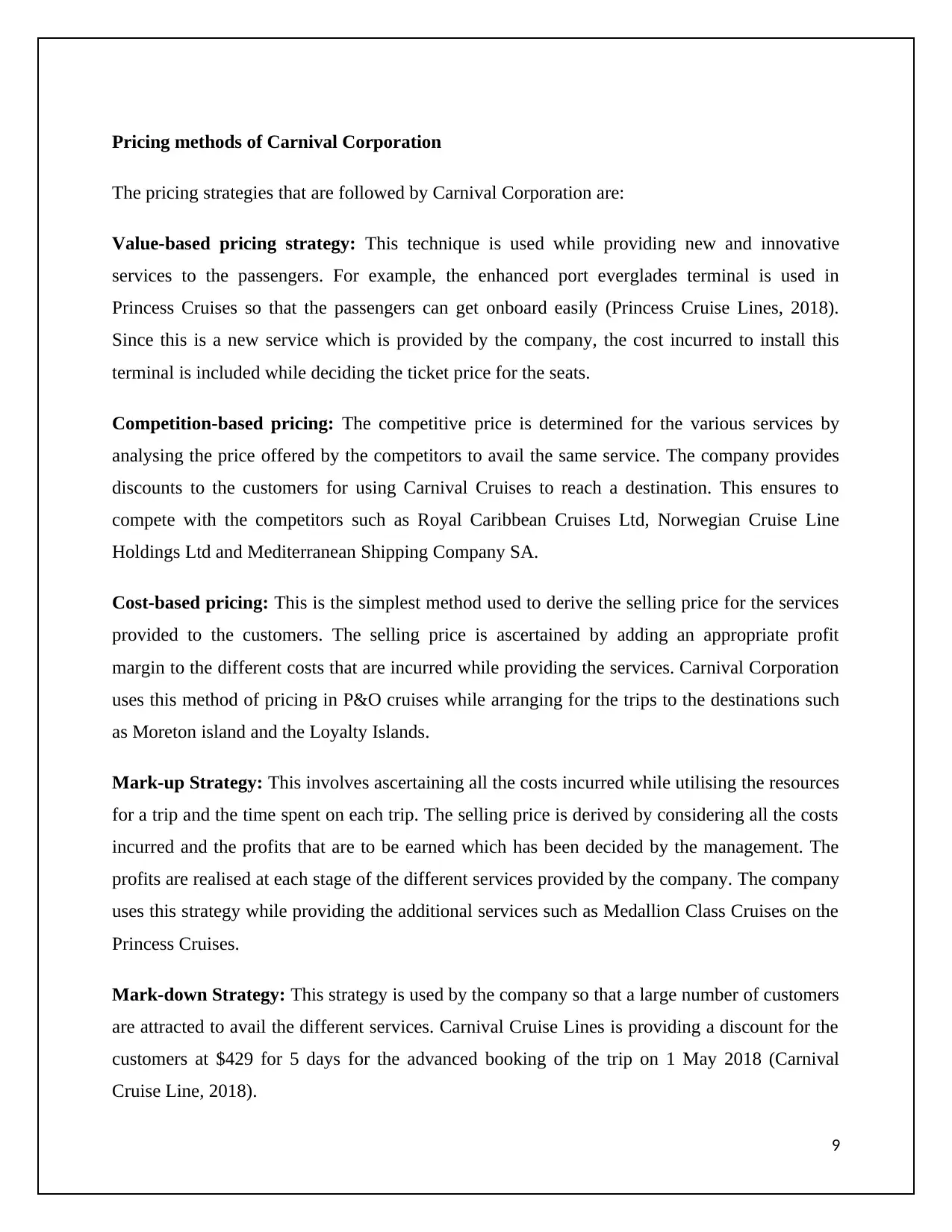
Pricing methods of Carnival Corporation
The pricing strategies that are followed by Carnival Corporation are:
Value-based pricing strategy: This technique is used while providing new and innovative
services to the passengers. For example, the enhanced port everglades terminal is used in
Princess Cruises so that the passengers can get onboard easily (Princess Cruise Lines, 2018).
Since this is a new service which is provided by the company, the cost incurred to install this
terminal is included while deciding the ticket price for the seats.
Competition-based pricing: The competitive price is determined for the various services by
analysing the price offered by the competitors to avail the same service. The company provides
discounts to the customers for using Carnival Cruises to reach a destination. This ensures to
compete with the competitors such as Royal Caribbean Cruises Ltd, Norwegian Cruise Line
Holdings Ltd and Mediterranean Shipping Company SA.
Cost-based pricing: This is the simplest method used to derive the selling price for the services
provided to the customers. The selling price is ascertained by adding an appropriate profit
margin to the different costs that are incurred while providing the services. Carnival Corporation
uses this method of pricing in P&O cruises while arranging for the trips to the destinations such
as Moreton island and the Loyalty Islands.
Mark-up Strategy: This involves ascertaining all the costs incurred while utilising the resources
for a trip and the time spent on each trip. The selling price is derived by considering all the costs
incurred and the profits that are to be earned which has been decided by the management. The
profits are realised at each stage of the different services provided by the company. The company
uses this strategy while providing the additional services such as Medallion Class Cruises on the
Princess Cruises.
Mark-down Strategy: This strategy is used by the company so that a large number of customers
are attracted to avail the different services. Carnival Cruise Lines is providing a discount for the
customers at $429 for 5 days for the advanced booking of the trip on 1 May 2018 (Carnival
Cruise Line, 2018).
9
The pricing strategies that are followed by Carnival Corporation are:
Value-based pricing strategy: This technique is used while providing new and innovative
services to the passengers. For example, the enhanced port everglades terminal is used in
Princess Cruises so that the passengers can get onboard easily (Princess Cruise Lines, 2018).
Since this is a new service which is provided by the company, the cost incurred to install this
terminal is included while deciding the ticket price for the seats.
Competition-based pricing: The competitive price is determined for the various services by
analysing the price offered by the competitors to avail the same service. The company provides
discounts to the customers for using Carnival Cruises to reach a destination. This ensures to
compete with the competitors such as Royal Caribbean Cruises Ltd, Norwegian Cruise Line
Holdings Ltd and Mediterranean Shipping Company SA.
Cost-based pricing: This is the simplest method used to derive the selling price for the services
provided to the customers. The selling price is ascertained by adding an appropriate profit
margin to the different costs that are incurred while providing the services. Carnival Corporation
uses this method of pricing in P&O cruises while arranging for the trips to the destinations such
as Moreton island and the Loyalty Islands.
Mark-up Strategy: This involves ascertaining all the costs incurred while utilising the resources
for a trip and the time spent on each trip. The selling price is derived by considering all the costs
incurred and the profits that are to be earned which has been decided by the management. The
profits are realised at each stage of the different services provided by the company. The company
uses this strategy while providing the additional services such as Medallion Class Cruises on the
Princess Cruises.
Mark-down Strategy: This strategy is used by the company so that a large number of customers
are attracted to avail the different services. Carnival Cruise Lines is providing a discount for the
customers at $429 for 5 days for the advanced booking of the trip on 1 May 2018 (Carnival
Cruise Line, 2018).
9
⊘ This is a preview!⊘
Do you want full access?
Subscribe today to unlock all pages.

Trusted by 1+ million students worldwide
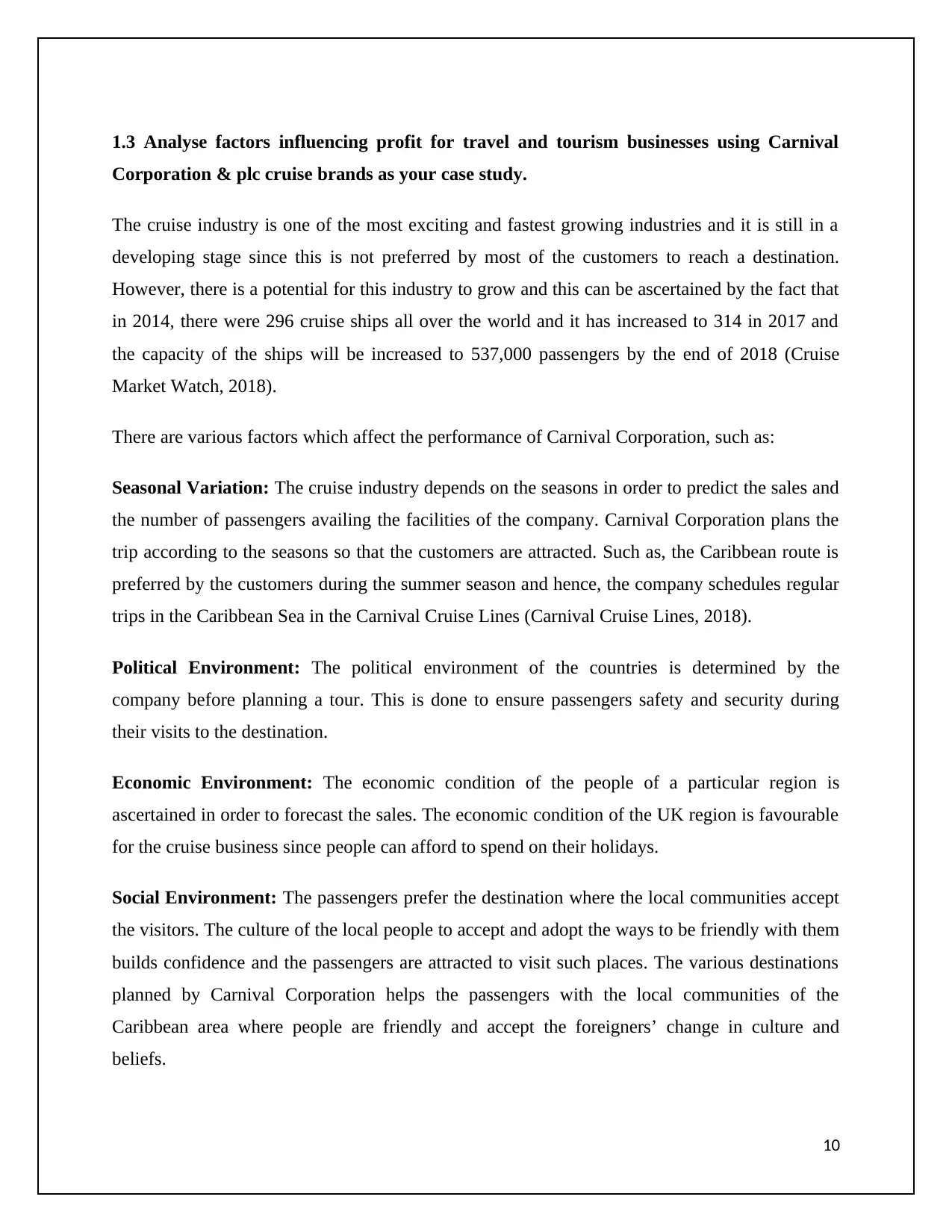
1.3 Analyse factors influencing profit for travel and tourism businesses using Carnival
Corporation & plc cruise brands as your case study.
The cruise industry is one of the most exciting and fastest growing industries and it is still in a
developing stage since this is not preferred by most of the customers to reach a destination.
However, there is a potential for this industry to grow and this can be ascertained by the fact that
in 2014, there were 296 cruise ships all over the world and it has increased to 314 in 2017 and
the capacity of the ships will be increased to 537,000 passengers by the end of 2018 (Cruise
Market Watch, 2018).
There are various factors which affect the performance of Carnival Corporation, such as:
Seasonal Variation: The cruise industry depends on the seasons in order to predict the sales and
the number of passengers availing the facilities of the company. Carnival Corporation plans the
trip according to the seasons so that the customers are attracted. Such as, the Caribbean route is
preferred by the customers during the summer season and hence, the company schedules regular
trips in the Caribbean Sea in the Carnival Cruise Lines (Carnival Cruise Lines, 2018).
Political Environment: The political environment of the countries is determined by the
company before planning a tour. This is done to ensure passengers safety and security during
their visits to the destination.
Economic Environment: The economic condition of the people of a particular region is
ascertained in order to forecast the sales. The economic condition of the UK region is favourable
for the cruise business since people can afford to spend on their holidays.
Social Environment: The passengers prefer the destination where the local communities accept
the visitors. The culture of the local people to accept and adopt the ways to be friendly with them
builds confidence and the passengers are attracted to visit such places. The various destinations
planned by Carnival Corporation helps the passengers with the local communities of the
Caribbean area where people are friendly and accept the foreigners’ change in culture and
beliefs.
10
Corporation & plc cruise brands as your case study.
The cruise industry is one of the most exciting and fastest growing industries and it is still in a
developing stage since this is not preferred by most of the customers to reach a destination.
However, there is a potential for this industry to grow and this can be ascertained by the fact that
in 2014, there were 296 cruise ships all over the world and it has increased to 314 in 2017 and
the capacity of the ships will be increased to 537,000 passengers by the end of 2018 (Cruise
Market Watch, 2018).
There are various factors which affect the performance of Carnival Corporation, such as:
Seasonal Variation: The cruise industry depends on the seasons in order to predict the sales and
the number of passengers availing the facilities of the company. Carnival Corporation plans the
trip according to the seasons so that the customers are attracted. Such as, the Caribbean route is
preferred by the customers during the summer season and hence, the company schedules regular
trips in the Caribbean Sea in the Carnival Cruise Lines (Carnival Cruise Lines, 2018).
Political Environment: The political environment of the countries is determined by the
company before planning a tour. This is done to ensure passengers safety and security during
their visits to the destination.
Economic Environment: The economic condition of the people of a particular region is
ascertained in order to forecast the sales. The economic condition of the UK region is favourable
for the cruise business since people can afford to spend on their holidays.
Social Environment: The passengers prefer the destination where the local communities accept
the visitors. The culture of the local people to accept and adopt the ways to be friendly with them
builds confidence and the passengers are attracted to visit such places. The various destinations
planned by Carnival Corporation helps the passengers with the local communities of the
Caribbean area where people are friendly and accept the foreigners’ change in culture and
beliefs.
10
Paraphrase This Document
Need a fresh take? Get an instant paraphrase of this document with our AI Paraphraser
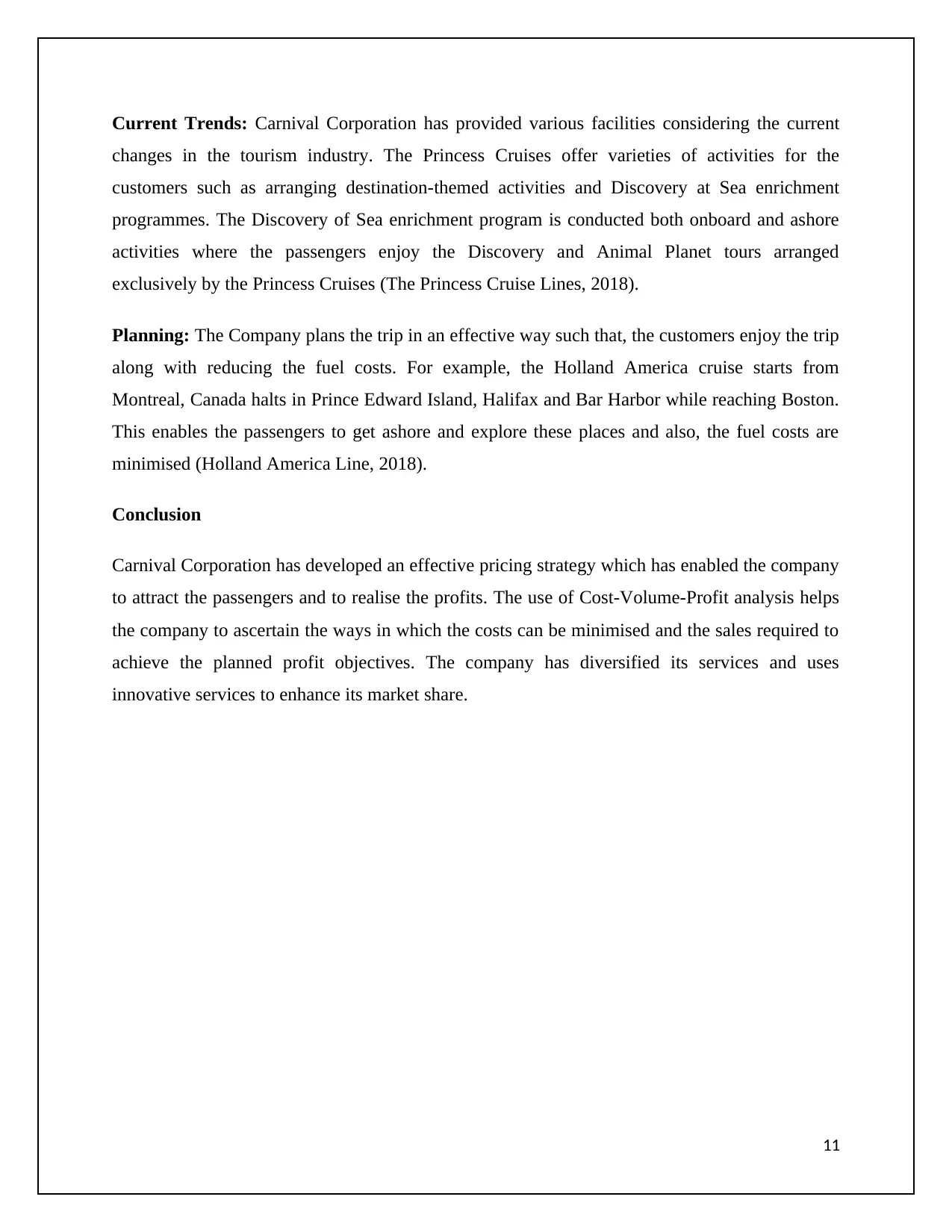
Current Trends: Carnival Corporation has provided various facilities considering the current
changes in the tourism industry. The Princess Cruises offer varieties of activities for the
customers such as arranging destination-themed activities and Discovery at Sea enrichment
programmes. The Discovery of Sea enrichment program is conducted both onboard and ashore
activities where the passengers enjoy the Discovery and Animal Planet tours arranged
exclusively by the Princess Cruises (The Princess Cruise Lines, 2018).
Planning: The Company plans the trip in an effective way such that, the customers enjoy the trip
along with reducing the fuel costs. For example, the Holland America cruise starts from
Montreal, Canada halts in Prince Edward Island, Halifax and Bar Harbor while reaching Boston.
This enables the passengers to get ashore and explore these places and also, the fuel costs are
minimised (Holland America Line, 2018).
Conclusion
Carnival Corporation has developed an effective pricing strategy which has enabled the company
to attract the passengers and to realise the profits. The use of Cost-Volume-Profit analysis helps
the company to ascertain the ways in which the costs can be minimised and the sales required to
achieve the planned profit objectives. The company has diversified its services and uses
innovative services to enhance its market share.
11
changes in the tourism industry. The Princess Cruises offer varieties of activities for the
customers such as arranging destination-themed activities and Discovery at Sea enrichment
programmes. The Discovery of Sea enrichment program is conducted both onboard and ashore
activities where the passengers enjoy the Discovery and Animal Planet tours arranged
exclusively by the Princess Cruises (The Princess Cruise Lines, 2018).
Planning: The Company plans the trip in an effective way such that, the customers enjoy the trip
along with reducing the fuel costs. For example, the Holland America cruise starts from
Montreal, Canada halts in Prince Edward Island, Halifax and Bar Harbor while reaching Boston.
This enables the passengers to get ashore and explore these places and also, the fuel costs are
minimised (Holland America Line, 2018).
Conclusion
Carnival Corporation has developed an effective pricing strategy which has enabled the company
to attract the passengers and to realise the profits. The use of Cost-Volume-Profit analysis helps
the company to ascertain the ways in which the costs can be minimised and the sales required to
achieve the planned profit objectives. The company has diversified its services and uses
innovative services to enhance its market share.
11
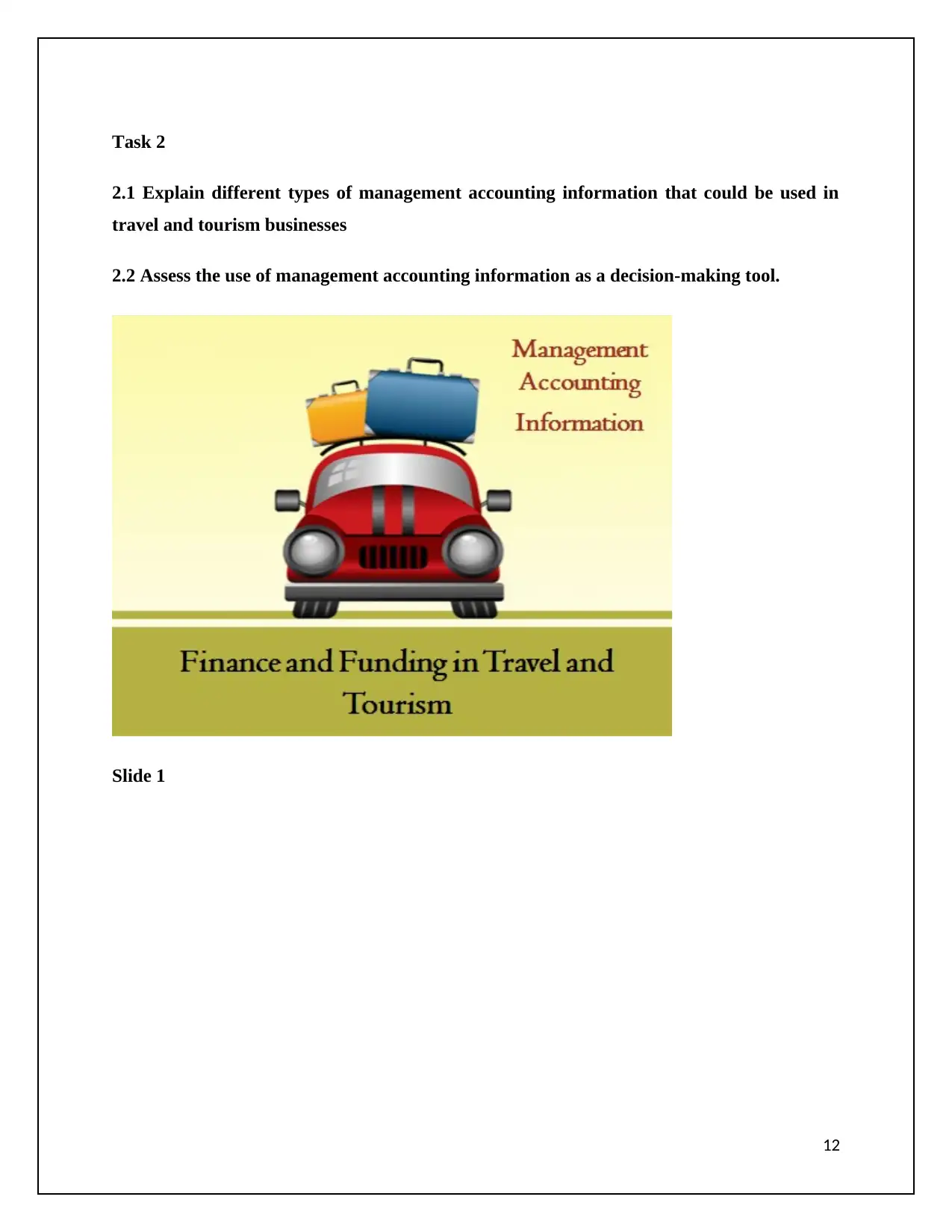
Task 2
2.1 Explain different types of management accounting information that could be used in
travel and tourism businesses
2.2 Assess the use of management accounting information as a decision-making tool.
Slide 1
12
2.1 Explain different types of management accounting information that could be used in
travel and tourism businesses
2.2 Assess the use of management accounting information as a decision-making tool.
Slide 1
12
⊘ This is a preview!⊘
Do you want full access?
Subscribe today to unlock all pages.

Trusted by 1+ million students worldwide
1 out of 38
Related Documents
Your All-in-One AI-Powered Toolkit for Academic Success.
+13062052269
info@desklib.com
Available 24*7 on WhatsApp / Email
![[object Object]](/_next/static/media/star-bottom.7253800d.svg)
Unlock your academic potential
Copyright © 2020–2025 A2Z Services. All Rights Reserved. Developed and managed by ZUCOL.





